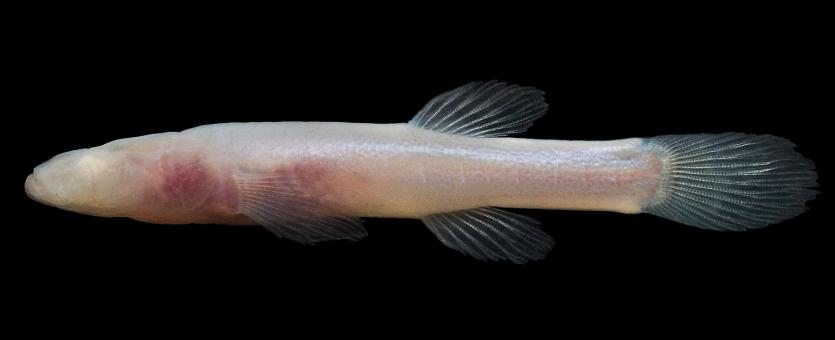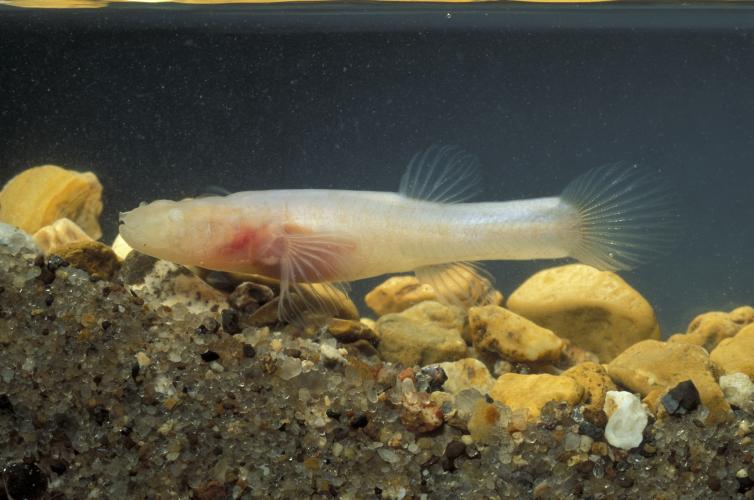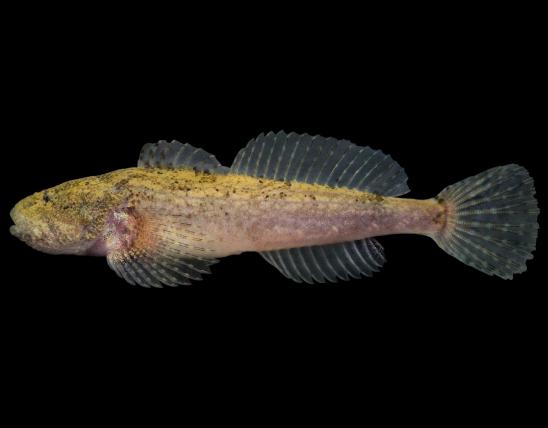
The southern cavefish has a long, flattened head without eyes (the only other Missouri fish that lacks eyes is the Ozark cavefish). Unpigmented, resulting in a whitish pink appearance due to blood vessels under the skin. Pelvic fins absent; tail fin is rounded. Scales are extremely small, giving the body the appearance of being scaleless. Anus located far forward on body, under throat in adults.
Similar species: Two other cavefish species are found in Missouri:
- The spring cavefish is known from only one site near Cape Girardeau; it is pigmented yellowish brown to brown, and it has small eyes.
- The Ozark cavefish lives in southwest Missouri. It is hard to distinguish the Ozark cavefish from the southern cavefish, but their ranges do not overlap.
Finally, the grotto sculpin is another Missouri fish that lives in caves and is pale, but it is not in the cavefish family and has a very different body shape.
Total length: 1½ to 2½ inches; maximum size to about 3½ inches.

Inhabits underground waters of central and southern Ozarks.
Habitat and Conservation
Only found in cave streams, wells, and spring outlets. Not believed to have any daily peak activity. Conservation efforts include protecting a cave's recharge area (the area of land through which water moves into springs or caves), minimizing disturbance to cave wildlife, and protecting cave entrances.
For a single cave system, the recharge area can be many miles wide. Pollutants, such as agricultural chemicals and animal waste, roadway runoff, leaking septic tanks, contaminants from trash thrown into sinkholes, and even excess silt from a variety of construction and agricultural earthworks, can seep into the groundwater, polluting caves, springs, and well water.
Food
Microcrustaceans, crayfish, and aquatic insect larvae. Cavefish have a low metabolic rate, which allows them to go without food for an extended period of time.
Status
A Species of Conservation Concern in Missouri. Threats include illegal collection for aquariums, groundwater pollution, groundwater removal, and habitat flooding by reservoir construction.
Life Cycle
Lifespan is unknown, believed to be longer than 10 years. It is believed that these cavefish spawn when water is high in February through April and that females carry the eggs in the gill chamber for 4 to 5 months until hatching. Up to 50 eggs can spawn from one female.
Human Connections
Human wealth takes many forms, in addition to the common sense of “money.” That Missouri — the Cave State — is blessed with such interesting subterranean features and an abundance of fascinating, rare, and elegant creatures, makes us rich beyond description.
Aquatic caves — ones with permanent or nearly permanent water — are fascinating, unique, and fragile. Humans have only a limited understanding of aquatic cave species and their interconnections.
Ecosystem Connections
Our three species of cavefishes live in specialized habitats. As some of the top underwater predators where they live, they occupy an important position.
There are many other remarkable animals that are so specialized for living in caves that they cannot survive outside the cave environment. These include cave crayfishes, the grotto sculpin and grotto salamander, and several species of flatworms, cave snails, arachnids, amphipods, copepods, isopods, millipedes, insects, and more.
Because they cannot live outside caves, a single pollution event affecting the groundwater seeping into the cave can potentially wipe out an entire population.




























